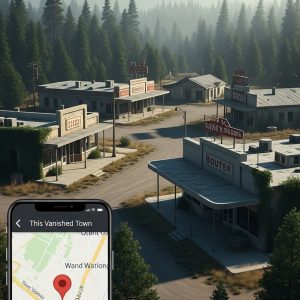Nestled between two ridges in rural West Virginia lies a town that shouldn’t exist—at least not according to Google Maps. Every day at exactly 12:00 AM, the town of Erwin vanishes from all digital maps, only to reappear the following morning.
We didn’t believe it either. But the GPS footage doesn’t lie.
Locals know not to talk about Erwin. One waitress in the next county whispered, “You can drive into it… but don’t stop your car.” When pressed, she simply said, “The town doesn’t like being watched.”
Curious (and admittedly skeptical), we visited Erwin ourselves. At 11:45 PM, the town looked like any other sleepy community—Victorian homes, a white chapel, even a diner with a neon “OPEN” sign. But at midnight sharp, something changed.
Our phones lost all signal. Google Maps reset, placing us back on Route 15… as if the last 20 miles didn’t exist. But we were still standing in Erwin, or something like it.
Streetlights flickered. A low hum—like power lines whispering—filled the air. And every person we’d seen earlier? Gone. Not a soul in sight.
In the town square, a faded plaque told part of the story: “Founded 1897. Erased 1971.” That’s when we found the local library—boarded shut but still containing a guestbook. The most recent entries were dated decades ago… except one.
“July 4, 2022: Still here. Still watching.”
Who wrote it? What causes the town to disappear digitally but remain physically present? Is it government cloaking tech? A localized glitch in the matrix? Or something much older?
We left before dawn. Once we hit the county line, our phones buzzed back to life. Google Maps showed no history of our trip. But our dashcam caught it all.
And one last thing:
In every photo we took…
The town sign says ‘Welcome to Erwin’—but it’s in our handwriting.
👉 Full video and images in the comments. Proceed with caution.





